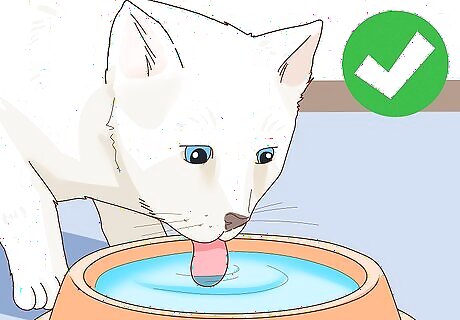
views
- If your cat is eating or drinking differently than it normally does, their blood sugar may be especially high or low.
- Weight fluctuations and excessive urination are common signs that your cat’s blood sugar isn’t stable.
- Glucose test strips are the easiest, cheapest way to test your cat’s blood sugar levels.
- If you need to check your cat’s blood sugar regularly, buy a blood glucose monitor.
Monitoring for Signs of Uncontrolled Blood Sugar

Monitor how much your cat is eating to assess its appetite. If your cat is not eating all of its food, or seems extra hungry and devours everything you put in front of it, then this is a sign that its blood sugar may be uncontrolled. Check the manufacturer’s recommendations or ask your veterinarian how much to feed your cat.

Check your cat’s fluid intake to determine if it's thirstier than usual. Excessive thirst is also a sign of uncontrolled blood sugar. If you notice that your cat is drinking more water than usual, tell your vet. For example, if your cat normally consumes about 3 fl oz (89 mL) of fluid in a 24 hour period, and its intake has doubled, then this could indicate a problem. Ask your cat’s veterinarian if you are unsure about how much water your cat should be drinking daily.

Measure your cat’s urine output to see if it is urinating more than normal. If your cat is urinating more than usual, then this is also a good indication that its blood sugar is not controlled. Check your cat’s litter box to see if it is putting out a larger volume of urine than they normally do. To get an accurate measurement of your cat’s urine output, use clumping litter and weigh the clumps after scooping them out each day. Keep in mind that your vet may also suggest doing a daily dipstick test on your cat’s urine to make sure there is glucose in its urine and it is safe to administer insulin.

Weigh your cat twice per month to see if its weight is fluctuating. Cats with uncontrolled blood sugar are also prone to rapid weight changes. If your cat suddenly loses or gains a pound, then take it to see your vet.Wondering how to care for a cat with diabetes? This will require a combination of changing your cat’s diet, monitoring its behavior and health, and administering insulin if needed.
Testing Your Cat’s Urine

Purchase glucose test strips from a drug store. The same glucose urine test strips that humans use will work for testing the glucose levels in your cat. These strips detect the amount of glucose in urine when you dip them into it, so they are easy to use and less invasive than testing your cat’s blood. Keep in mind that urine testing is not a reliable way to determine how much insulin to administer. It will only indicate if it is safe to give your cat its normal dose of insulin.

Fill your cat’s litter box with a non-absorbing litter. The urine needs to stay in liquid form for best results, so remove the absorbent litter from your cat’s box and replace it with something that will not soak up the urine. It is best to use something that resembles litter so that your cat will still want to use its box. Some good options include: Commercial non-absorbing cat litter Aquarium gravel Styrofoam packing peanutsNeed to test your cat’s urine in a hurry? Mix a clump of litter with 8 fl oz (240 mL) of water and dip the strip in it. This will not give you as accurate of a result as testing urine alone, but it is an option if you need to check your cat’s glucose levels and don’t have time to empty their box and add non-absorbing litter.

Dip a test strip into fresh urine in the litter box and read it. After your cat has urinated in the box, take a new test strip and dip it into the pooled urine. You may need to tilt the box slightly to get all of the urine into a corner so that you can dip the strip into it. If the test strip shows that glucose is present in the urine, then it is safe to administer your cat’s normal dose of insulin. Use a litter scoop to move the non-absorbent litter material to the side if it is in your way.

Replace the non-absorbing litter with regular clay litter after testing. Throw away the non-absorbing litter and put your cat’s regular litter back into the box after you test its urine. The non-absorbing litter is only meant for temporary use. Make sure to put fresh, clean litter into your cat’s box. Do not reuse old litter.
Using a Blood Glucose Monitor

Check your cat’s blood sugar as often as your vet recommends. Your cat’s veterinarian will advise you about how often you need to check your cat’s blood glucose and how to go about it. Since a single test may not provide helpful information unless your cat’s blood sugar is too low, a 24 or 12 hour curve test is often required to show how effective your cat’s current insulin dose is and whether it needs to be adjusted. This type of test requires a blood sample every 1 to 2 hours.

Talk with your veterinarian before using a blood glucose test. If you want to test at home, ask your cat’s veterinarian about it first. They can recommend a monitor and instruct you on how to use the device on your cat. You can purchase a special blood glucose monitor meant for cats. These are easy to use and relatively inexpensive. Keep in mind that checking your cat’s blood glucose levels at home may not be necessary if your cat’s blood sugar levels are under control. You can always bring your cat into the veterinarian’s office for routine checks or if something seems off.

Administer the test before or 6 hours after your cat’s last meal. When you need to administer the test will depend on what your vet is checking for. You may need to test before your cat has eaten if your vet is concerned about high blood sugar, or 6 hours after your cat has eaten if your vet suspects low blood sugar. Eating raises your cat’s blood glucose levels, so it is important to wait until your cat has processed its food to test. For example, if you need to wait until 6 hours after your cat last ate, and your cat last ate at 6:00 am, then wait until 12:00 pm to test.

Draw blood from your cat’s ear or a toe pad. Both of these locations are acceptable for drawing blood for a blood glucose test. Only a small drop of blood is required. Press the device against your cat’s ear or toe pad and press the button to extend the lance and draw the blood. It is important to keep your cat calm while you take the test, so choose the location that seems less bothersome to your cat.

Read the results. The device should provide a read of the blood glucose level within a couple of minutes. The normal range is between 75 and 120 mg. If your cat’s blood sugar levels are within this range, then it is normal. If the number is above or below this range, then it is abnormal. Call your cat’s veterinarian to set up an appointment. For example, a blood sugar level of 60 would be considered low. A blood sugar level of 130 is considered high. Be aware that perfect blood sugar will not be possible because you cannot constantly monitor and administer micro doses of insulin to your cat. Your cat’s blood sugar will sometimes fall outside of the normal range and that is okay as long as your cat is healthy otherwise. Talk with your vet if you have concerns.

Take your cat to the veterinarian for a blood glucose curve test. Multiple blood draws and readings may be required to determine if your cat is suffering from uncontrolled blood sugar or diabetes. If you have concerns about your cat’s behavior or if you get an abnormal reading on one of the tests you do, then call your veterinarian to set this up. Your cat may need to stay at the veterinarian’s office all day or overnight. The test requires a blood sample every 1 to 2 hours over an 8, 12, or 24 hour period. The samples provide your veterinarian with more data to help them make a diagnosis.Tip: Keep your cat as calm as possible before and during the test. Stress can affect your cat’s blood glucose levels.




















Comments
0 comment